The opportunity to send a proposal can be exciting. Maybe you're exploring more work with an existing client. Or, perhaps you're responding to a request for proposal (RFP).

If a current or potential client requests your proposal, you should consider the content of your RFP response as serious business. Because it probably means you're competing for your customer’s attention with other vendors who might have sent similar proposals.
Download Now: Free RFP Templates
For how time-sucking and frustrating proposal creation can be, your hopes of getting hired by a client are too often met with disappointment. So, what'll make your proposal stick out? What will give your team a creative outlet and make a difference for your own growth goals?
Jason Swenk, an entrepreneur, and former agency owner, recently discussed his formula for creating proposals that had an 80% close rate and led him to work with brands such as AT&T, Legal Zoom, and Hitachi at HubSpot's Partner Day. Here are his steps for creating a killer proposal.
.png)
Free RFP Templates
Fill out the form to get these templates.
- One-Pager RFP
- Longer In-Depth RFP
- Designed PDF RFP
Download Free
All fields are required.
.png)
Table of Contents
- How to Respond to an RFP
- Free RFP Response Template
- RFP Response Examples
- Tips for Winning More Proposals
How to Respond to an RFP
- Carefully review the RFP to understand what the client wants.
- Determine the deliverables with your team to determine whether your company can meet them.
- Create a draft using answers and insights from your team.
- Distribute the draft among the team.
- Edit the draft and use clear, concise language.
- Submit your final proposal to the client.
1. Carefully review the RFP to understand what the client wants.
When you receive an RFP, the first thing to do is carefully review it to understand what the client wants you to do. This first step will help you filter out projects that lie outside the scope of your organization or team.
2. Determine the deliverables with your team to determine whether your company can meet them.
Your team offers a fresh set of eyes that can help everyone get on the same page and determine whether the deliverables required can be completed by your organization.
3. Create a draft using answers and insights from your team
Before you create the proposal, it’s critical to determine whether the client is the right match for your services. Therefore, you should properly research the prospective client. Determine who they are, what their values are, their market, and what they’re all about.
It's also a good idea to request input and insights from the team. Combining your research with answers and insights from your team will help you to create a good first draft.
4. Distribute the draft among the team
Creating a great proposal requires having all the necessary information. Therefore, after creating the first draft, share it among the team for review and request their input on specific details.
5. Edit the draft and use clear, concise language.
Review and edit the draft and send out the final version for approval. Close the review and add finishing touches to the proposal.
6. Submit your final proposal to the client.
Finally, submit the finished proposal to the client and await their response.
With all that said, take a look at the six components Swenk says make for a proposal template that clients are more likely to respond to.
The RFP Response Template That Gets an 80% Close Rate
"It needs to be in a certain order, like a phone number," Swenk said. "You have to have the right order to reach the right person."
Take a look at the six elements you need to create the perfect RFP response, along with some abbreviated examples of the language you might use when drafting each element of your proposal.
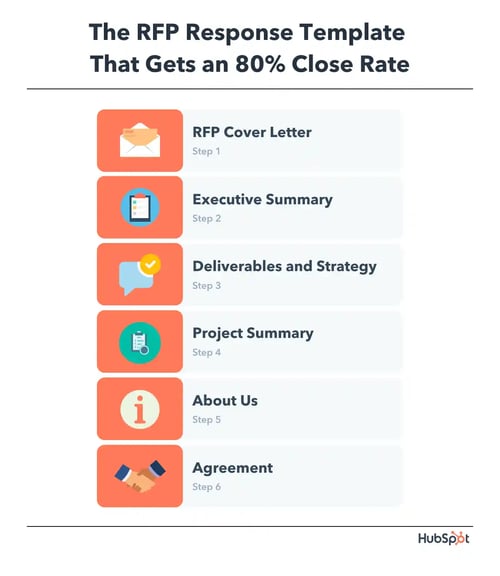
1. RFP Cover Letter
Don't just dive right into the strategy and the tactics. Set expectations upfront and entice the client to read more.
Think of the opening of your proposal or RFP response as the cover letter of a job application. It really is, after all; you want this company to hire your team, but they need a more digestible summary of what you'll offer them and why you think they'll benefit from working with you.
This cover letter gives them the proper context around who you are before reading about the services you intend to offer them. It also gives you the opportunity to remind them that they solicited the proposal they're about to read from you.
RFP Cover Letter Example
Dear [author of RFP]:
Regarding your request for proposal (RFP), [your company] is thrilled about the opportunity to provide you [type of service requested]. Having worked with [brief list of past clients], we believe a partnership with [company you're writing to] would have a tremendous impact on your customer satisfaction and bottom line.
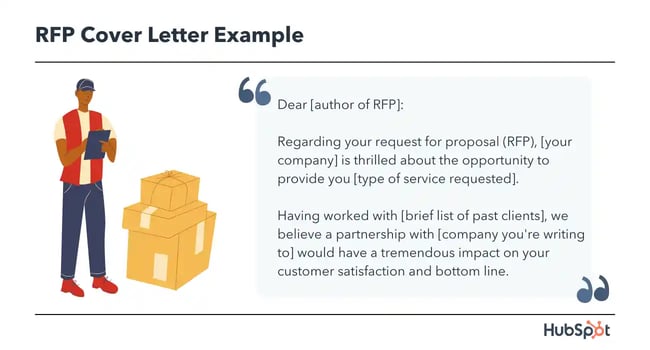
Don't just stop there. Follow the above introduction with a description of who you are, what qualifies you to work with the RFP's sender, and the benefits your potential client can expect to see as a result.
2. Executive Summary
The executive summary shouldn't just summarize what the proposal says. Instead, it should state what the prospect wants, where they want to go, and what they will need to get there. You will also want to cover the research you did, who you did interviews with, and the steps you took to pull together your recommendations. This document shows why the client should select your firm.
One important piece of advice from Swenk on the summary: State two obvious facts about the requester or the requester's needs up front. These should be things that the client knows are true. By doing this first, the reader will be more receptive to the remaining points. This isn't about tricking someone. It's about presenting the information in a way that prevents the client from becoming defensive when reading your recommendations.
Executive Summary Example
As one of [client's industry] leading providers of [client's main service], you know just how critical this time of year can be for your customers. On average, the cost to deliver is $[xxxx.xx], and [client name] is committed to "[client's mission statement]."
As these challenges become more common, it is increasingly important to provide customers with a solution that's driven by [your industry]'s latest knowledge and expertise. With this in mind, [your company] intends to help [client's name]:
- [Client benefit #1]
- [Client benefit #2]
- [Client benefit #3]
.png)
Free RFP Templates
Fill out the form to get these templates.
- One-Pager RFP
- Longer In-Depth RFP
- Designed PDF RFP
Download Free
All fields are required.
.png)
3. Deliverables and Strategy
This is the heart of your proposal document.
Categorize the proposal into different sections, such as creative, technology, etc. This will make it easy for the prospect to understand the different parts of the proposal and the different activities being recommended. In each section, you should list out the specific deliverables and also indicate what is not included. This last part helps to prevent scope creep from the beginning, and it also serves as an inspiration for clients who may want more.
Finally, don't include pricing in this section. It will stop people from absorbing the information, and it will prevent the reader from getting excited by the work you can do together. Instead, they'll just be thinking about dollar signs and their dwindling budget. Also, putting a price immediately prompts a person to begin comparing your pricing to another firm's price, no matter what the solution you are recommending actually includes.
Deliverables and Strategy Example
As stated in the executive summary, [your company] intends to help [client's name] [brief allusion to client benefits outlined in executive summary]. To do this, our team has outlined a proposed set of deliverables, an order of operations, division of labor, and expected dates of completion to ensure the partnership between [your company] and [client's name] is successful.
|
DELIVERABLE |
TEAM MEMBERS |
START DATE |
COMPLETION DATE |
|
xx |
xx, xx, and xx |
xx/xx/xxxx |
xx/xx/xxxx |
|
xx |
xx, xx, xx, and xx |
xx/xx/xxxx |
xx/xx/xxxx |
|
xx |
xx and xx |
xx/xx/xxxx |
xx/xx/xxxx |
Throughout these operations, we expect your team to see heightened efficiency across your organization and progressively higher customer satisfaction over our [length of project or proposed contract] project. It's important to note, however, that the deliverables outlined below do not include:
- [Product/service not included]
- [Product/service not included]
- [Product/service not included]
4. Project Summary
After the Deliverables and Strategy document, you can then add an itemized list of all the deliverables and a price for each.
This isn't to give your client an option, where they cherry pick this and that and that and not this. The client wants a recommendation. You can't put the weight of the decision on their shoulders by asking them to choose between this package and that package. Give them a solid plan for what needs to be done and what it will cost them. Then, tailor the solution during a conversation.
Project Summary Example
[Your company] can't wait to work with you to help [client's name] in addressing [client's challenges described in Executive Summary]. To recap, please see below a brief overview of the services included in this partnership:
|
SERVICE |
DELIVERABLES INCLUDED |
TOTAL COST OF SERVICE |
|
xx |
xx and xx |
$xxx.xx |
|
xx |
xx, xx, and xx |
$xxx.xx |
|
xx |
xx |
$xxx.xx |
5. About Us
Save this part until the end. The client won't care about you until they know what you can do for them and their company.
The About Us section of your RFP response can be identical to the company description you likely created when starting your venture. As a general guideline, always open your About Us section with the name of your company. In the case of an RFP, keep in mind your potential client is receiving many responses at once, and it can be difficult to remember all the companies pitching to them.
6. Agreement
Lastly, include an agreement or contract in the proposal so that the client can sign as soon as possible. Don't make them ask you: where do I sign?
Oftentimes clients will flip directly to the agreement or contract section of your proposal, so make sure it's clearly labeled and the signature lines are visible at the bottom. After all, the signature of your client is some valuable ink to have ... you want to make their ability to provide it no less clear than the services you're offering them.
RFP Response Examples
1. SaaS Services RFP Response
If you have a SaaS business model, you can look at this response example as a template.
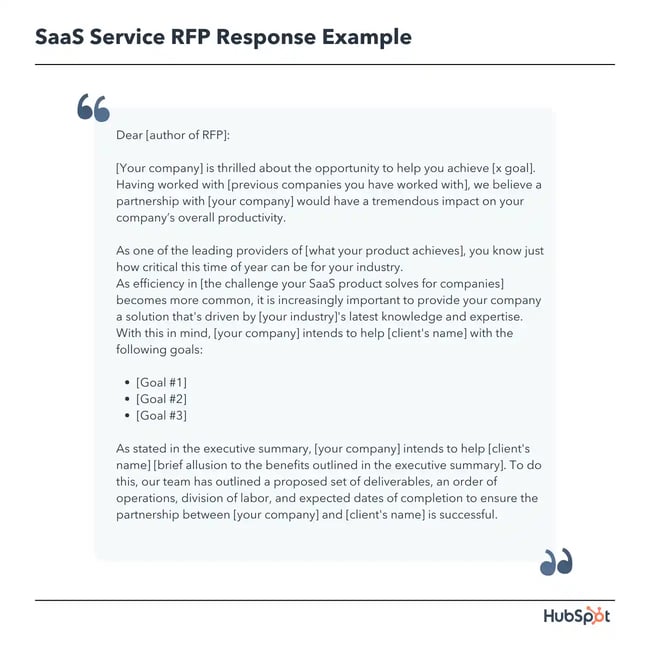
Dear [author of RFP]:
[Your company] is thrilled about the opportunity to help you achieve [x goal]. Having worked with [previous companies you have worked with], we believe a partnership with [your company] would have a tremendous impact on your company’s overall productivity.
As one of the leading providers of [what your product achieves], you know just how critical this time of year can be for your industry.
As efficiency in [the challenge your SaaS product solves for companies] becomes more common, it is increasingly important to provide your company a solution that's driven by [your industry]'s latest knowledge and expertise. With this in mind, [your company] intends to help [client's name] with the following goals:
- [Goal #1]
- [Goal #2]
- [Goal #3]
As stated in the executive summary, [your company] intends to help [client's name] [brief allusion to the benefits outlined in the executive summary]. To do this, our team has outlined a proposed set of deliverables, an order of operations, division of labor, and expected dates of completion to ensure the partnership between [your company] and [client's name] is successful.

2. Marketing Services RFP Response
If you are a marketing company, consider this template to start your RFP:
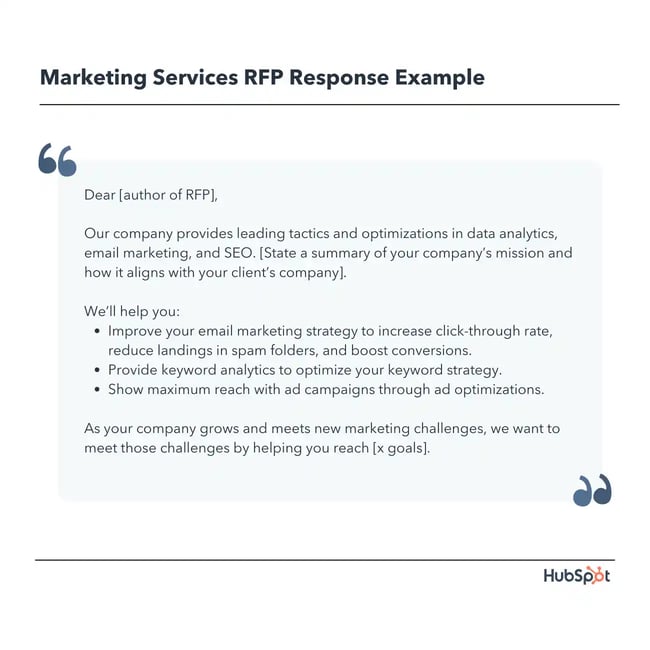
Dear [author of RFP],
Our company provides leading tactics and optimizations in data analytics, email marketing, and SEO. [State a summary of your company’s mission and how it aligns with your client’s company]. We’ll help you:
- Improve your email marketing strategy to increase click-through rate, reduce landings in spam folders, and boost conversions.
- Provide keyword analytics to optimize your keyword strategy.
- Show maximum reach with ad campaigns through ad optimizations.
As your company grows and meets new marketing challenges, we want to meet those challenges by helping you reach [x goals].

3. Coaching Services RFP Response
If you offer coaching services, consider this as a template for your RFP response:

Dear [author of RFP],
Our company’s mission is to provide [company’s mission statement].
We believe this aligns with the integrity and vision of your business. With our services, you’ll achieve the following goals:
- Erase executives’ self-limiting beliefs, which may be stopping the company from achieving its vision.
- Bring clarity to your company’s core values, which will increase the efficiency of your marketing and sales efforts.
- Empower your high-level and mid-level executives to change and improve the company culture.
Our coaching services work best when the company is ready to advance to a new level. These goals will unlock growth and exceed your desired outcomes.

4. Training Services RFP Response
If you offer training services, consider this template as an RFP response:
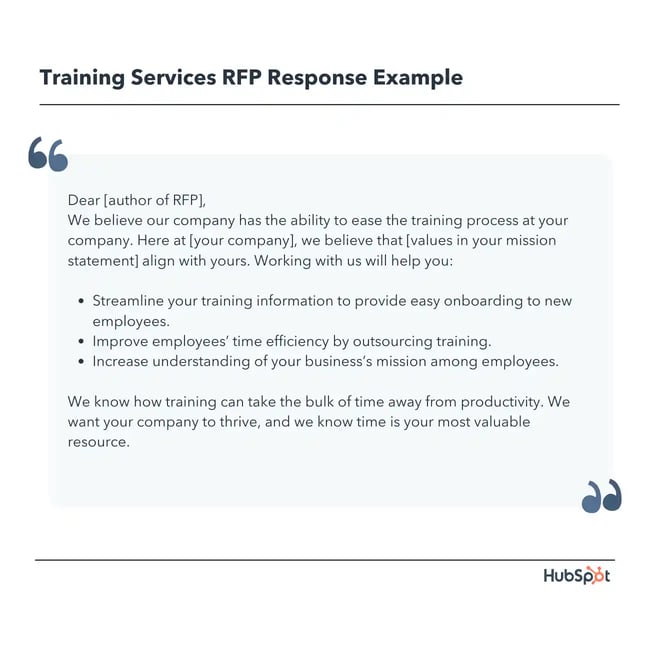
Dear [author of RFP],
We believe our company has the ability to ease the training process at your company. Here at [your company], we believe that [values in your mission statement] align with yours. Working with us will help you:
- Streamline your training information to provide easy onboarding to new employees.
- Improve employees’ time efficiency by outsourcing training.
- Increase understanding of your business’s mission among employees.
We know how training can take the bulk of time away from productivity. We want your company to thrive, and we know time is your most valuable resource.

We recommend that you download our free proposal templates for even more proposal templates.
.png)
Free RFP Templates
Fill out the form to get these templates.
- One-Pager RFP
- Longer In-Depth RFP
- Designed PDF RFP
Download Free
All fields are required.
.png)
RFP Response Best Practices
1. Don’t Get Ahead of Yourself
Oftentimes, during an informal discussion with a prospective client, the agency owner will hear the words, "Just send me a proposal." The owner thinks this is a sign that the client wants to commit. In fact, many clients just see this as a first date or even a "sure, just call me sometime."
So, the agency's staff spends hours and hours creating a detailed pitch deck, and the owner emails it within 48 hours.
I'm sure you can guess what comes next: silence.
It’s understandable to get excited when a prospective client expresses interest in your services. While immediately crafting a proposal shows dedication and speed, it’s important not to get ahead of yourself.
Make sure you’re sending over a flawless, thorough RFP response – which may take more time and effort than you were hoping for.
2. Ask the Right Questions
Before you even get to creating the proposal, you first need to determine if the client is wasting your time. If the client isn’t the right match for your services, why should you even make the investment in creating this document?
You can quickly avoid situations where you are just sending out proposal after proposal by figuring out the client's BANT.
- Budget: How much is the client prepared to pay for the need?
- Authority: Does the person reading your proposal have a say in the decision?
- Need: What is the client looking for?
- Timing: How long will the client need to decide?
”When you start taking on clients just because of the money, you are going to have problems later on,” Swenk said.
3. Emphasize Precision, Facts, and Proper Expectations
By switching your response strategy from being the first company to submit a response to being the best agency to submit a response, you set yourself up with a greater chance to close the deal and deliver on clear, feasible, and appropriate expectations for the prospective client.
This means moving away from generalized responses like “our agency is committed to completing the project on time and within budget every time,” toward hyper-focused responses such as “our agency will complete [set tasks] by [desired date] with a budget of [dollars], specifically by completing [action item #1], [action item #2], and [action item #3].”
4. Use an RFP Response Template [Outline Below]
Make sure you leave no topic unaddressed that your contact may want information on. Information about your company, the team your client would be working with, and expectations around budget, timeline, and deliverables should be crystal clear.
This specificity is even more necessary for contacts you have not yet spoken. Use the RFP response to explain your company’s background and your process for driving ROI.
Finally, you can do two important things to make your closing rates increase.
Review the proposal with the prospective client. Don't just send it over and hope for a response. And state that this is a mandatory requirement. When a client requests a proposal, schedule a meeting to review the information. If they can't commit to a meeting, you shouldn't be spending your time crafting this in-depth document.
“Be able to walk away," Swenk said. "They are just shopping, and they are going to waste your time.”
Next, build your proposal template. Once you have the ideal structure in place, build a template you can use with every prospect. There's no need to start from the beginning each time. This will save you time and will lead to higher conversions as the prospect won't have enough time for buyer's remorse to sink in.
A proposal should be the result of numerous discussions with the prospective client. There should be no surprises — either in price or the strategy that you are suggesting — and it should be seen as a written review of your processes and the conversations with your client.
Providing Value and Solutions For Your Client
When responding to an RFP, you want to make the scope of your project clear and communicate undeniable value to your client. Once you outline the scope of the project and the benefits the client will receive, you are more likely to close the deal and establish a successful business relationship with your client company.
Editor's note: This post was originally published in May 2015 and has been updated for comprehensiveness.
RFPs
![What is a Marketing Proposal, and How Can You Create One? [Template Included]](https://53.fs1.hubspotusercontent-na1.net/hubfs/53/marketing%20proposals-1.jpg)
![8 Best Tips for Business Proposal Presentations [+Examples]](https://53.fs1.hubspotusercontent-na1.net/hubfs/53/business-proposal-presentations.jpeg)

